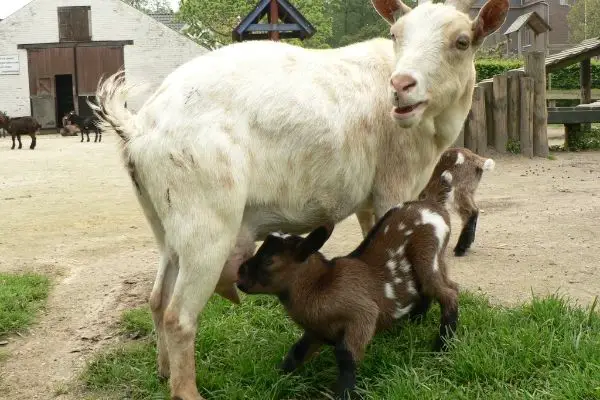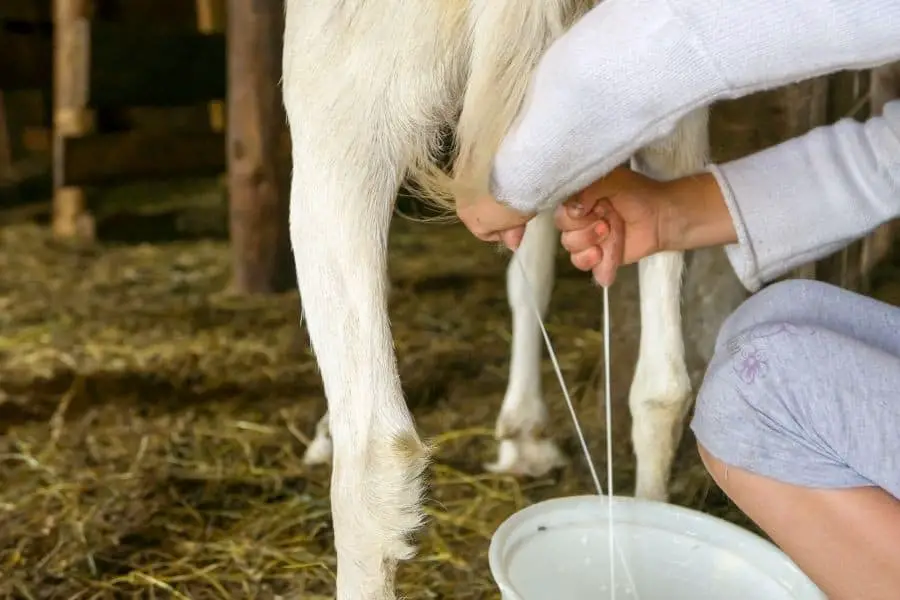Dairy goats are a great addition to the barnyard or even a backyard. They are a reliable source of dairy but require less space and effort than cows. However, owning dairy goats still comes with regular responsibilities, including frequent milking.
If you don’t milk a dairy goat, it will cause discomfort, pain, and even health complications. The goat’s udders will painfully swell with milk. She could even get an udder infection called mastitis. You should stop milking your dairy goat only if you are attempting to place her in a drying-up period.
How Long Can a Dairy Goat Go Without Milking?
How long you can leave your dairy goat alone without milking her will depend on a few different factors. If the kids are not weaned yet, just put them together with the mother. You will not have to worry about milking at all because the baby goats will take care of all of the work for you!
However, if a goat does not have nursing kids or they are not with her full time, then she will need to be milked at least once a day. Skipping one day may not cause dire consequences for the goat, but it will put her through a lot of unnecessary pain.
How Often Should I Milk My Dairy Goat?
Goats cannot go for a very long time without getting milked. You will need to milk them once or twice a day, depending on how much milk they produce and their nursing schedules.
If the kids are fully weaned or do not spend any time with their mother, then you will have to milk the goat twice a day. While this is extra responsibility for you, it also means that you will have more milk for your household and your business.

Many dairy farmers allow kids to nurse for part of the day and separate them from the mother at night. This means that you will have to milk the goat only once a day, in the morning, after her udders have had time to replenish during the night.
Finally, if your goat was (un)lucky enough to have twins and is nursing both, you may not need to milk her at all. All the milk will be going to those hungry babies.
Do You Have to Milk a Goat Like You Have to Milk a Cow?
There are a few similarities between milking goats and cows. The milking technique is similar. They both have udders, so you need to pinch the top of the teat and squeeze it down to extract all the milk. No matter what animal you are milking, it is a forearm workout!

Some of the precautions you have to take will be similar, whether you are milking a cow or a goat. You need to clean the udders regularly, usually with warm water and gentle soap. Both cows and goats are prone to mastitis, an infection of the mammary glands, so you will have to check for that in both animals.
However, there are a few ways that milking a goat is easier than milking a cow. Even when your goat is producing the most milk, and you are not competing with her kids for the supply, you will have to milk her less frequently than you would a cow. Overall, goats require less work since they are smaller.
Milking a goat is also less intimidating than a cow. While some dairy goats have quite the temper, and you may need to get a feed collar to restrain them during milking, they are much smaller than cows and will cause less damage even if they start kicking.
If you are just starting in the world of dairy farming, milking a goat can seem safer than a cow that weighs over a thousand pounds.
The Why and How to Dry up a Dairy Goat
Drying up a dairy goat seems antithetical to the goals of a dairy farm.
After all, your goats will not produce milk while they are dry. However, drying up dairy goats helps them rest and regain their strength after lactating. It can also help boost future milk production once the goat has kids again and get rid of toxins and medicine that could affect the milk quality.
Most dairy farmers dry up their goats after a lactation period of about 300 days. The process of getting the goat to stop producing milk lasts a few weeks.
How Do I Know If My Goat Udder Is Empty?
An empty udder will feel loose and deflated to the touch. It will also look smaller compared to a full, swollen udder.
If you are not trying to dry out your goats and notice that the udder is full, but no milk is coming out, that could be your goat’s attempt to trick you.
Some goats can hold back a little milk in their udder for their kids, meaning that you can squeeze all you want, and nothing is coming out. Try bumping the udder a little with your hand, which will knock the milk loose.
How Can I Tell If My Goat Has Mastitis?
One of the most frequent problems when a goat is milked infrequently, is mastitis. Mastitis is an infection affecting the mammary glands or udders.
Besides irregular milking, it can also be caused by stress and dirty living conditions that allow bacteria to breed.
You can usually tell if a goat has mastitis by examining its milk. If you notice that naturally fluid milk now has clotting or streaks, that could be a symptom of mastitis. Your goat’s udders could also feel swollen and tender.
If you think your goat has mastitis, contact a vet immediately. This is a painful condition and could affect your goat’s future milk production.
The veterinarian will prescribe antibiotics for your goat, and you may need to stop using infected goat’s milk for a while until the antibiotics are out of her system.
To prevent mastitis, clean your goat’s pen regularly and wash her teats every time you milk her. Some farmers dip the teats in warm water before they milk because that prevents mastitis. You should also milk your goats at least once a day because swollen udders are more prone to mastitis.
Dairy goats are gentle, forgiving barn animals, but they still come with responsibilities. Be prepared to milk your goats at least once a day, if not twice unless they are in their drying up period. If you don’t milk a dairy goat, you cause the animal lots of pain, leading to more serious health conditions such as mastitis.
